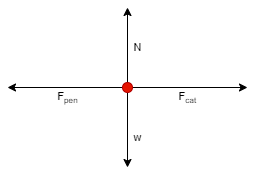According to Newton’s Third Law of Motion, a body exerting force on another body experiences a force equal in magnitude and opposite in direction. As bodies experience acceleration proportional to the magnitude of the force and inversely proportional to their mass, lighter objects exerting force on heavier ones accelerate away faster (Urone & Hinrichs, 2020). This force, however, may not be enough to give the heavier body sufficient acceleration to move it. Demonstrations of this law are ubiquitous in nature, and examples are common: most motion relies on this principle, be it walking, swimming, or flying.

One particular example of a Third Law force pair can be seen in a cat pushing a small object, such as a pen, off a table. The cat applies force to the pen, causing it to roll rightward. At the same time, the cat experiences the same amount of force in the direction opposite to the push. However, as the cat’s mass is significantly less than that of the pen, it does not move. At the same time, both the cat and the pen experience the downward force of their weights and the upward normal force from the table. These forces are also equal, hence, neither the cat nor the pen have any vertical acceleration.
References
Urone, P. P., & Hinrichs, R. (2020). College physics. OpenStax.